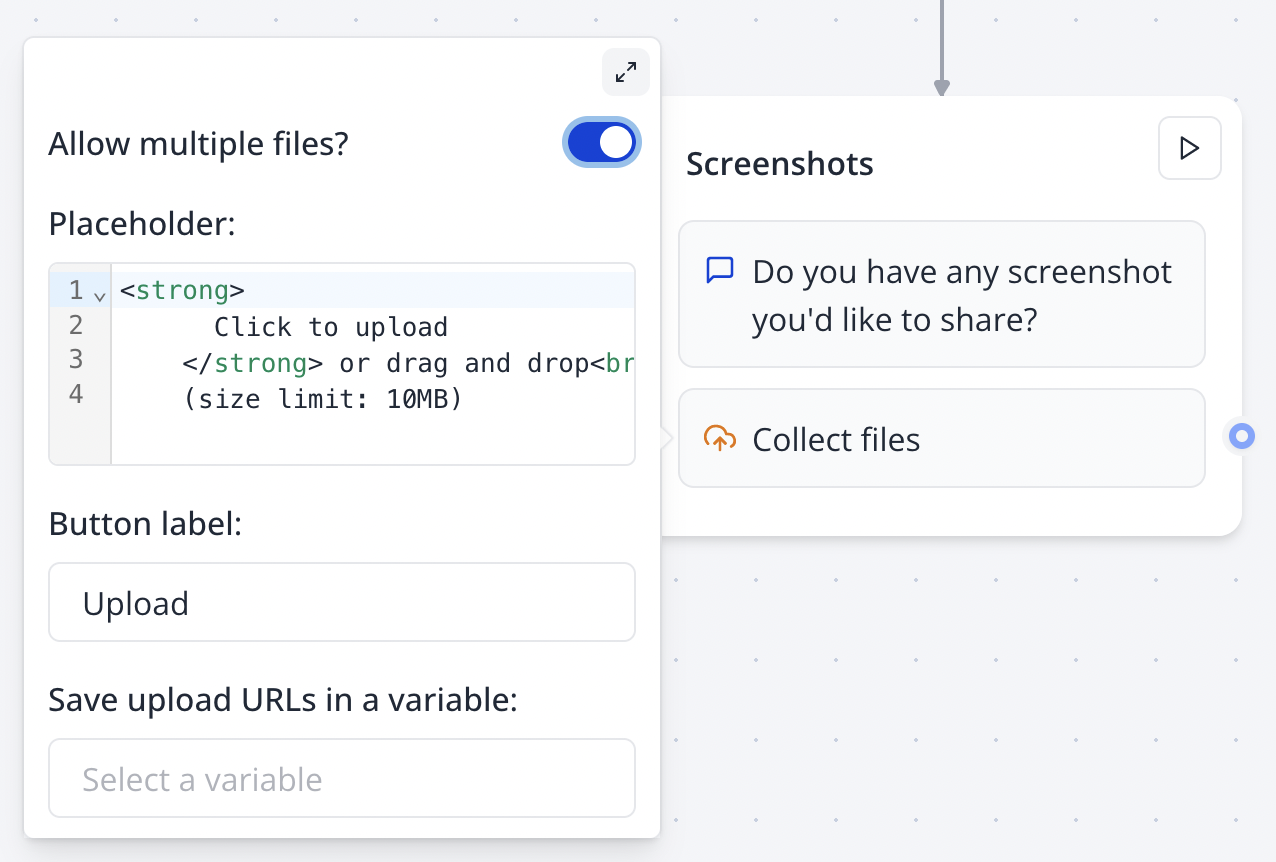Configuration Options
File Upload Settings
- Required: Make file upload mandatory or optional for form completion
- Allow Multiple Files: Enable users to upload multiple files in a single interaction
- Placeholder: Custom HTML-enabled content displayed in the upload area
- Visibility: Control whether uploaded files are publicly accessible or private
Custom Labels
Comprehensive labeling system with context-aware options:- Button Label: Text for the submit/upload button
- Clear Label: Text for clearing selected files (multiple files only)
- Skip Label: Text for skipping upload (when not required)
- Success Labels: Different messages for single vs. multiple file uploads
Variable Integration
- Save Upload: Choose a variable to store file URLs or file information
- Variable content adapts based on single vs. multiple file configuration
- Flow
- Bot

HTML Placeholder Support
The placeholder field accepts HTML for rich formatting:- Use HTML tags to style instructions
- Include images or icons in upload areas
- Create visually appealing upload prompts
- Support for basic HTML elements and styling
HTML Examples
File Size and Type Limitations
Size Limit
There is a 10MB fixed limit per uploaded file. For larger files:- Direct users to cloud storage services (Google Drive, Dropbox, OneDrive)
- Request shareable links instead of direct uploads
- Consider breaking large files into smaller parts
- Implement file compression recommendations
File Type Handling
The block accepts all file types by default:- Images: JPG, PNG, GIF, SVG, WebP
- Documents: PDF, DOC, DOCX, TXT, RTF
- Archives: ZIP, RAR, 7Z
- Media: MP4, MP3, AVI, WAV
- Data: CSV, XLS, XLSX, JSON
Visibility Options
Public vs. Private Files
Choose how uploaded files are accessible: Public Files:- Generate publicly accessible URLs
- Anyone with the link can view files
- Compatible with external services and integrations
- Suitable for sharing and embedding
- Restricted to workspace members only
- Require authentication to access
- Cannot be used with external services
- Enhanced security for sensitive documents
- Public for web-based uploads
- Private for WhatsApp and other messaging platforms
- Platform-optimized visibility settings
Integration Impact
Public files enable:- Email attachments via Send email block
- Integration with external APIs
- Direct linking in webhooks
- Embedding in external websites
- External service access
- Direct URL sharing
- Third-party integrations
- Public embedding capabilities
Multiple File Upload
Configuration Options
When multiple file upload is enabled:- Users can select several files at once
- Clear button allows removing all selected files
- Success message includes total count using
{total}placeholder - Variable stores array of file URLs
Success Message Templates
- Single file: “File uploaded successfully!”
- Multiple files: “Uploaded files successfully!”
- Customize messages to match your brand voice
- Include file count for user confirmation
Advanced Features
Conditional Labels
Labels automatically adapt based on configuration:- Skip button only appears when upload is not required
- Clear button only appears for multiple file uploads
- Success messages change based on single vs. multiple mode
File Preview
Uploaded files show:- Image thumbnails for visual files
- File names and types for documents
- Upload progress indicators
- Remove/clear options
Mobile Optimization
- Touch-friendly upload interface
- Camera integration for mobile uploads
- Drag-and-drop support where available
- Responsive layout adaptation
Best Practices
User Experience
- Provide clear instructions in placeholder text
- Set appropriate file size expectations
- Use descriptive button labels
- Include file format guidance when specific types are needed
Security Considerations
- Use private visibility for sensitive documents
- Consider file scanning for malware
- Implement appropriate access controls
- Regular cleanup of unused uploaded files
Performance
- Monitor storage usage with multiple file uploads
- Implement file retention policies
- Consider image compression for large uploads
- Use appropriate visibility settings for your use case
Integration Examples
Single File Upload
Multiple File Upload
Troubleshooting
Common Issues
Files not uploading- Check file size is under 10MB limit
- Verify internet connection stability
- Ensure browser supports HTML5 file uploads
- Test with different file types
- Confirm a variable is selected in settings
- Check that upload completes successfully
- Verify visibility settings don’t restrict access
- Ensure workspace has sufficient storage
- Verify “Allow multiple files” is enabled
- Check browser compatibility with multiple file selection
- Test file selection method (drag-drop vs. browse)
- Confirm clear button functionality
- Understand public vs. private implications
- Test file URLs in intended integration context
- Verify workspace member access for private files
- Check external service compatibility requirements
Plan Restrictions
File upload blocks may have plan-specific limitations:- Free plans may restrict file upload functionality
- Check plan features before implementing file uploads
- Upgrade required messages appear during publishing
- Multiple file uploads may require higher plan tiers
Integration Considerations
- Parse file URLs correctly in webhook handlers
- Handle array format for multiple file uploads
- Implement appropriate error handling for failed uploads
- Consider file cleanup and retention policies
- Test visibility settings with intended downstream systems

